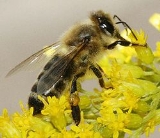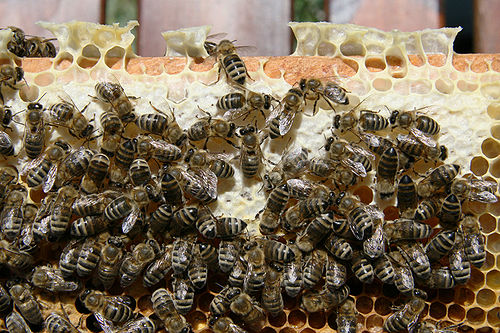
Carniolan honeybee
Encyclopedia
The Carniolan honey bee (Apis mellifera carnica Pollman) is a subspecies of the western honey bee. The Carniolan honey bee is native to Slovenia
and to some regions of the former Yugoslavia
, southern Austria
, and parts of Hungary
, Romania
, and Bulgaria
.
is the subspecies of the Western honey bee that has naturalized and adapted to the Kočevje
(Gottschee) sub-region of Carniola
(now in Slovenia
), the southern part of the Austria
n Alps
and the northern Balkans
. These bees are known as Carniolans, or "Carnies" for short, in English. At present this subspecies is the second most popular among beekeepers (after the Italian bee
). It is favored among beekeepers for several reasons, not the least being its ability to defend itself successfully against insect pests while at the same time being extremely gentle in its behavior toward beekeepers. These bees are particularly adept at adjusting worker population to nectar availability. It relies on these rapid adjustments of population levels to rapidly expand worker bee populations after nectar becomes available in the spring, and, again, to rapidly cut off brood production when nectar ceases to be available in quantity. It meets periods of high nectar with high worker populations and consequently stores large quantities of honey
and pollen
during those periods. They are resistant to some diseases and parasites that can debilitate hives of other subspecies.
 Carniolan bees are nearly as big and long as the Western European black bees
Carniolan bees are nearly as big and long as the Western European black bees
, though their abdomens are much slimmer. Furthermore, the Carniolan bee has a very long tongue (6.5 to 6.7 mm, which is very well adapted for clover), a very high elbow joint and very short hair.
Not beneficial

Slovenia
Slovenia , officially the Republic of Slovenia , is a country in Central and Southeastern Europe touching the Alps and bordering the Mediterranean. Slovenia borders Italy to the west, Croatia to the south and east, Hungary to the northeast, and Austria to the north, and also has a small portion of...
and to some regions of the former Yugoslavia
Yugoslavia
Yugoslavia refers to three political entities that existed successively on the western part of the Balkans during most of the 20th century....
, southern Austria
Austria
Austria , officially the Republic of Austria , is a landlocked country of roughly 8.4 million people in Central Europe. It is bordered by the Czech Republic and Germany to the north, Slovakia and Hungary to the east, Slovenia and Italy to the south, and Switzerland and Liechtenstein to the...
, and parts of Hungary
Hungary
Hungary , officially the Republic of Hungary , is a landlocked country in Central Europe. It is situated in the Carpathian Basin and is bordered by Slovakia to the north, Ukraine and Romania to the east, Serbia and Croatia to the south, Slovenia to the southwest and Austria to the west. The...
, Romania
Romania
Romania is a country located at the crossroads of Central and Southeastern Europe, on the Lower Danube, within and outside the Carpathian arch, bordering on the Black Sea...
, and Bulgaria
Bulgaria
Bulgaria , officially the Republic of Bulgaria , is a parliamentary democracy within a unitary constitutional republic in Southeast Europe. The country borders Romania to the north, Serbia and Macedonia to the west, Greece and Turkey to the south, as well as the Black Sea to the east...
.
Origin
The beeBee
Bees are flying insects closely related to wasps and ants, and are known for their role in pollination and for producing honey and beeswax. Bees are a monophyletic lineage within the superfamily Apoidea, presently classified by the unranked taxon name Anthophila...
is the subspecies of the Western honey bee that has naturalized and adapted to the Kočevje
Kocevje
Kočevje is a city and a municipality in southern Slovenia. In terms of area it is the largest municipality in Slovenia. It is located between the rivers Krka and Kolpa and is part of the traditional region of Lower Carniola. It is now included in the Jugovzhodna Slovenija statistical region...
(Gottschee) sub-region of Carniola
Carniola
Carniola was a historical region that comprised parts of what is now Slovenia. As part of Austria-Hungary, the region was a crown land officially known as the Duchy of Carniola until 1918. In 1849, the region was subdivided into Upper Carniola, Lower Carniola, and Inner Carniola...
(now in Slovenia
Slovenia
Slovenia , officially the Republic of Slovenia , is a country in Central and Southeastern Europe touching the Alps and bordering the Mediterranean. Slovenia borders Italy to the west, Croatia to the south and east, Hungary to the northeast, and Austria to the north, and also has a small portion of...
), the southern part of the Austria
Austria
Austria , officially the Republic of Austria , is a landlocked country of roughly 8.4 million people in Central Europe. It is bordered by the Czech Republic and Germany to the north, Slovakia and Hungary to the east, Slovenia and Italy to the south, and Switzerland and Liechtenstein to the...
n Alps
Alps
The Alps is one of the great mountain range systems of Europe, stretching from Austria and Slovenia in the east through Italy, Switzerland, Liechtenstein and Germany to France in the west....
and the northern Balkans
Balkans
The Balkans is a geopolitical and cultural region of southeastern Europe...
. These bees are known as Carniolans, or "Carnies" for short, in English. At present this subspecies is the second most popular among beekeepers (after the Italian bee
Italian bee
Apis mellifera ligustica is the Italian bee which is a sub-species of the western honey bee .- Origin :The Italian honey bee is thought to originate from the continental part of Italy, South of the Alps, and North of Sicily...
). It is favored among beekeepers for several reasons, not the least being its ability to defend itself successfully against insect pests while at the same time being extremely gentle in its behavior toward beekeepers. These bees are particularly adept at adjusting worker population to nectar availability. It relies on these rapid adjustments of population levels to rapidly expand worker bee populations after nectar becomes available in the spring, and, again, to rapidly cut off brood production when nectar ceases to be available in quantity. It meets periods of high nectar with high worker populations and consequently stores large quantities of honey
Honey
Honey is a sweet food made by bees using nectar from flowers. The variety produced by honey bees is the one most commonly referred to and is the type of honey collected by beekeepers and consumed by humans...
and pollen
Pollen
Pollen is a fine to coarse powder containing the microgametophytes of seed plants, which produce the male gametes . Pollen grains have a hard coat that protects the sperm cells during the process of their movement from the stamens to the pistil of flowering plants or from the male cone to the...
during those periods. They are resistant to some diseases and parasites that can debilitate hives of other subspecies.
Anatomy and appearance
Carniolan honey bees are about the same size as the Italian honey bee race, but they are physically distinguished by their generally dusky brown-grey color that is relieved by stripes of a subdued lighter brown color. Their chitin is dark, but it is possible to find lighter colored or brown colored rings and dots on their bodies. They are also known as the "grey bee".
European dark bee
The European dark bee was domesticated in modern times, and taken to North America in colonial times. These small, dark-colored honey bees are sometimes called the German black bee, although they occurred originally from Britain to eastern Central Europe.There are three main races,...
, though their abdomens are much slimmer. Furthermore, the Carniolan bee has a very long tongue (6.5 to 6.7 mm, which is very well adapted for clover), a very high elbow joint and very short hair.
Character and behavior
Beneficial- Considered to be gentle and non-aggressive
- Can be kept in populated areas.
- Sense of orientation considered better than the Italian honey bee race
- Less drifting of bees from one hive to a neighboring hive
- When compared to the Italian race, they are not as prone to rob honey
- Able to overwinter in smaller numbers of winter bees; honey stores are conserved.
- Able to quickly adapt to changes in the environment
- Better for areas with long winters
- Rhythm of brood production very steep. Brood rearing is reduced when available forage decreases
- Low use of propolisPropolisPropolis is a resinous mixture that honey bees collect from tree buds, sap flows, or other botanical sources. It is used as a sealant for unwanted open spaces in the hive. Propolis is used for small gaps , while larger spaces are usually filled with beeswax. Its color varies depending on its...
- Resistant to brood diseases
- For areas with strong spring nectar flowNectar sourceA nectar source is a flowering plant that produces nectar as part of its reproductive strategy. These plants create nectar, which attract pollinating insects and sometimes other animals such as birds....
and early pollination - Forage earlier in the morning and later in the evening, and on cool, wet days.
- Workers live up to 12% longer than other breeds
Not beneficial
- More prone to swarming if overcrowded
- Low ability to thrive in hot summer weather
- Strength of broodnest more dependent on availability of pollen
- Unless marked the dark queenQueen beeThe term queen bee is typically used to refer to an adult, mated female that lives in a honey bee colony or hive; she is usually the mother of most, if not all, the bees in the hive. The queens are developed from larvae selected by worker bees and specially fed in order to become sexually mature...
is difficult to find


